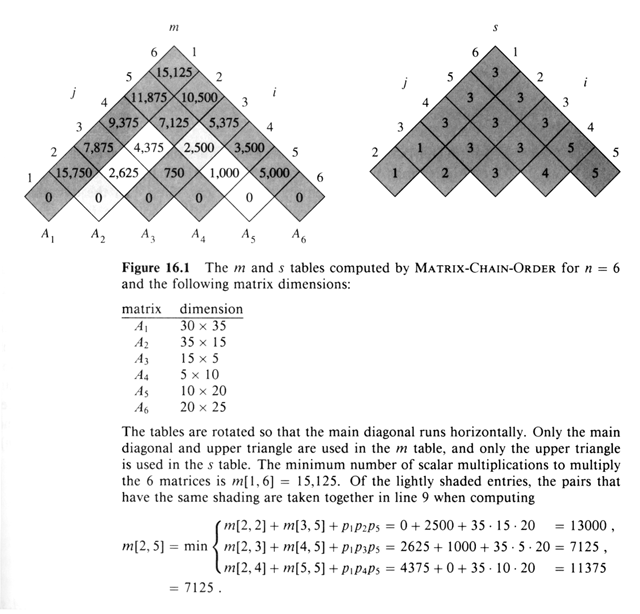Dynamic Programming
Divide-and-Conquer: break problems into independent
sub problems.
Dynamic Programming: break problems into dependent
sub problems, save sub problem solutions to reuse if applicable.
DP is used to solve optimization problems, which often could
require "testing" many possible solutions. The single best
solution is called the optimal solution. DP's four steps:
-
Characterize the structure of an optimal solution.
-
Recursively define the value of an optimal solution.
-
Compute the value of an optimal solution bottom-up.
-
Construct an optimal solution from computed information,
Often only the value of the optimal solution is required so
4 is not necessary.
An example problem to be solved with DP:
Matrix-chain multiplication:
<A1, A2, A3, ...,An>
, n matrices to be multiplied together.
| ®® |
®® |
|
|
|
|
|
|
| a11 |
a12 |
¯ |
b11 |
b12 |
= |
c11 |
c12 |
| a21 |
a22 |
¯ |
b21 |
b22 |
= |
c21 |
c22 |
c11 = a11 b11 + a12 b21
A x B
= C
(p x q) (q x r) (p x r)
The length of the loop cost p q r multiplications.
Grouping matters: We define the order of performing our multiplications
by grouping using parenthesis. A matrix product is fully parenthesized if it
is:
- a single matrix
- the product of two fully parenthesized products surrounded by
parenthesis.
<A1, A2, A3,A4>
- ( A1 ( A2 ( A3A4 )))
- ( A1 (( A2 A3 )A4 ))
- (( A1 A2 ) ( A3A4 ))
- (( A1 ( A2 A3 )) A4 )
- ((( A1 A2 ) A3 )A4 )
Five parenthesis with four matrices.
DP Step 1: What is the structure of an optimal parenthesization?
How much can different parenthesizations cost?
<A1, A2, A3>
A1: 10 x 100
A2: 100 x 5
A3: 5 x 50
(( A1 A2) A3)
( A1 A2 ) : 10 x 100 x
5 = 5000
(( A1 A2) A3) : 10 x 5 x 50 = 2500
7500 multiplications
( A1 ( A2 A3 ))
( A2 A3 ) : 100 x 5 x
50 = 25000
( A1 (A2 A3)) : 10 x 100 x 50
= 50000
75000 multiplications
Matrix-Chain multiplication problem: Given <A1, A2,
A3, ...,An> (Ai is pi-1 x pi)
fully parenthesize A1, A2, A3, ...,An in
a way that minimizes the number of scalar multiplications. How many
parenthesizations are there? Given a chain of n matrices, we may split them
between k and k + 1 for any k = 1,2, ..., n - 1. Then we parenthesize the
remaining halves.
P (n) = 1 , if n = 1
| P (n) = |
n - 1
å
k = 1 |
P (k) P ( n-k ), if n £
2 |
|
P (n) = C (n-1) , the (n-1)st catalan number
C (n) = 1/ (n+1) ( 2 n / n ) = 1/(n+1) ( 2 n (2 n-1)... (n+1))/ (
n(n-1)...(2)1)
= Omega ( 4n /n3/2
), exponential # of parenthesizations
P (3) = C (2) = 2
P (4) = C (3) = 5
P (5) = C (4) = 14
P (6) = C (6) = 42
A i...j = A i A i+1 ... A j
To parenthesize we first pick k: A 1...k A k+1 ...n Cost
of this parenthesization is
- A 1...k
- A k+1 ...n
- multiplying the two parts together.
For the optimal parenthesization
- k chosen must be optimal
- parenthesization of A 1...k and of A k+1 ...n must
be optimal
Why:
- ® if not, not optimal
- ® if not, can use the optimal to lessen
our work n the big problem.
Recursions:
m [i,j] = min # of scalar multiplications A 1...k
We seek m[1,n].
Clearly m [i,i] = 0, i = 1,2,...,n
m[i,j] = m[i,k] + m[k+1,j] + pi-1 pk pj
If we knew the optimal k! So: m[i,j] = 0 if i = j, and:
min
i £ k < j |
{m[i,k] + m[k+1,j] + pi-1 pk pj
} i < j |
So that we can construct the optimal solution we also define: s [i,j]
= k that produces the minimum. We need to compute m[i,j] 1 £
i £ j £ n
(n/2) + n = (n(n-1))2 + n = (n(n+))/2, diagonal and lower diagonal.
Matrix-Chain-Order (p)
- n ¬ length[p] - 1
- for i ¬ 1 to n
- do m[i,i] ¬ 0
- for l ¬ 2 to n
- do fro i ¬ 1 to n - l + 1
- do j ¬ i
+ l - 1
- m[i, j] ¬
¥
- for k ¬
i to j - 1
-
do q ¬ m[i,k] + m[k+1, j] + pi-1 pk
pj
-
if q < m[i,j]
-
then m[i,j] ¬ q
-
s[i,j] ¬ k
- return m and s

The above just determined the cost of the optimal solution. We must use
the s[i, j] results to construct the optimal. So the information is fed
to:
Matrix-Chain-Multiply ( A, s, i, j )
- if j > i
- then X ¬ Matrix-Chain-Multiply
( A, s, i, s[i, j] )
- X ¬
Matrix-Chain-Multiply ( A, s, s[i, j] + 1,j )
- return
Matrix-Multiply (X, Y)
- else return Ai
In the example of Figure 16.1, the call Matrix-Chain-Multiply ( A, s,
1, 6 ) computes the matrix-chain product according to the parenthesization
(( A1 (A2 A3 ))(( A4 A5
) A6 ))
|







